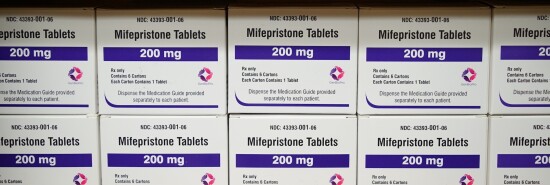
FDA is wrong again: Abortion pills are not safe to take at home
David Gortler
Video Embed
The abortion drug mifepristone (Mifeprex) entered the U.S. market in 2000. For the past two decades, the drug’s official labeling stated some permutation of the following: “Mifeprex…Administration must be under the supervision of a qualified physician,” and “Mifeprex may be administered only in a clinic, medical office, or hospital, by or under the supervision of a physician, able to assess the gestational age of an embryo and to diagnose ectopic pregnancies.”
These warnings are further reflected and elaborated upon on the websites of the Mayo Clinic and the NIH’s National Library of Medicine.
NEVER FORGET THOSE WHO SHUT DOWN COVID-19 DEBATE TO PROTECT CHINA
Yet the FDA is now not only approving but promoting Big Pharma’s proposal to permit mailed, at-home use of mifepristone for “do it yourself” abortions. No more doctor or staff present. No more ultrasounds to confirm gestational age or any in-house monitoring for complications for internal bleeding… for a drug well established to cause life-threatening bleeding.
What changed? Did the FDA just unearth data showing that mifepristone is safer than originally thought? The answer is no. In fact, mifepristone is so unsafe that it could only be dispensed under the FDA’s Risk Evaluation and Mitigation Strategy protocol since 2011. REMS protocols are only issued to high-risk drugs, which means that mifepristone is one of the rarely selected FDA-approved drugs which, although approved, has unusual “serious safety concerns.”
In its recent decision, the FDA did release a medical review. But anyone looking for scientifically meaningful reasoning based on cumulative safety findings will be both disappointed and outraged. What they will find are many small, non-safety-prioritized studies and the redundant authorship of pro-abortion campaigners and study sponsorship from places such as the National Abortion Federation and the biased UCSF Bixby Center for Global Reproductive Health.
Indeed, the studies referenced were shamefully deceptive, and instead of referencing “safety,” they used muddy, academically unacceptable language, such as “unplanned clinical encounters.”
The few studies the FDA relied on for its safety determination were not prospectively, longitudinally, statistically, or appropriately designed safety-centric studies, despite mifepristone currently being a REMS product. Further, studies that did reference safety used in-house monitoring and ultrasounds to confirm the age of the fetus and evaluate bleeding, which are now no longer necessary. Importantly, the one study the FDA referenced with a noteworthy number of participants required in-patient visits and still concluded that the drug regimen increased hospital visits.
The laughable, non-clinical, and irrelevant conclusions of some studies that the FDA used to justify its decision included: “Medication abortion with mail-order pharmacy dispensing of mifepristone appears effective, feasible, and acceptable to patients.” While “feasible and acceptable” is…nice to know, it’s unrelated to the FDA’s safety mission statement on assuring drug safety.
The justification that the FDA gives in its report for skirting essentially every safety requirement it had in place decades prior to 2021 is: “the COVID-19 public health emergency,” which President Joe Biden has already decided to end.
Cumulative safety and women’s health should be the FDA’s ultimate concern. However, the studies referenced in the medical review were mysteriously limited to an approximate three-year window from 2019-2021. Of note, that window only included when mifepristone was limited to use in a doctor’s office and only through 49 days’ gestation. In contrast, today’s requirements depend on women unreliably self-assessing gestation up to 70 days. The FDA deceitfully states in its review that “there have been no new safety concerns identified,” but it ignores existing safety concerns and contemptibly omits multiple, large specially designed safety studies with obviously negative findings published during the same 2019-2021 time period.
Then there’s what the FDA removed from its report. Generally, FDA redactions of anything related to public health are questionable, but this time the FDA took the unprecedented maneuver of hiding not only the authors of the medical review but also the name of the FDA division which wrote the report. That same roughly 100-page FDA medical review was then signed off by the FDA’s senior executive leadership in less than one hour, with all the signers’ names redacted as well. The signature timeline casts serious doubt upon whether or not signers actually read the review.
You don’t have to read between the lines to figure out that the FDA’s mifepristone decision was not clinical or scientific. Mailing abortion pills seems to be a thinly disguised partisan response by the White House that deliberately ignores comprehensive safety findings and just another radical pro-abortion response by the Biden administration to the Dobbs decision.
Unfortunately, it’s just one more in a series of dozens of examples of the FDA ignoring clear clinical data pointing in the opposite direction to force through unproven edicts.
CLICK HERE TO READ MORE FROM THE WASHINGTON EXAMINER
Today’s FDA has become a marionette performing for the Biden White House and Big Pharma. This new and concerning trend shows no signs of stopping. In the meantime, the cumulative safety profile of mifepristone predicts that the FDA’s decision to allow the mailing of abortion drugs for at-home use will lead to preventable morbidity and mortality in America’s women and children.
Dr. David Gortler is an FDA and health care policy oversight fellow and FDA reform advocate at the Ethics and Public Policy Center in Washington, DC. He is a former professor of pharmacology and biotechnology at the Yale University School of Medicine, a former FDA senior medical analyst, and a senior advisor to the FDA commissioner for drug safety, FDA science policy, and FDA regulatory affairs.
